Game Design and Development Project: Prototype Creation and Testing
VerifiedAdded on 2022/12/19
|12
|3722
|226
Project
AI Summary
This project delves into the multifaceted world of game design and development. It begins by exploring various idea generation methods, including storyboards, brainstorming, mood boards, sketches, concentration, and the SCAMPER technique, alongside the factors that influence the generation of successful game ideas, such as relation level, administration tools, participation, communication, decision-making, and risk-taking. The project then moves on to the practical aspects, providing a list of gaming ideas and the associated design thought processes for different game genres, such as action, adventure, role-playing, simulation, strategy, sports, and puzzle games. It also covers the formulation of a game design proposal with supportive documentation, focusing on a puzzle game concept. The core of the project involves the creation of a functional gaming prototype, detailing the steps involved, from paper to software design, user interface modelling, and virtual prototype creation, to adding input/output, engineering algorithms, and iterative testing. Furthermore, the project discusses refining a game prototype through iterative testing, outlining the requirements, analysis, design, testing, implementation, review, deployment, and maintenance phases of the iterative model. The project encompasses methods, factors, and processes to create and refine a functional game prototype.

Design
Paraphrase This Document
Need a fresh take? Get an instant paraphrase of this document with our AI Paraphraser
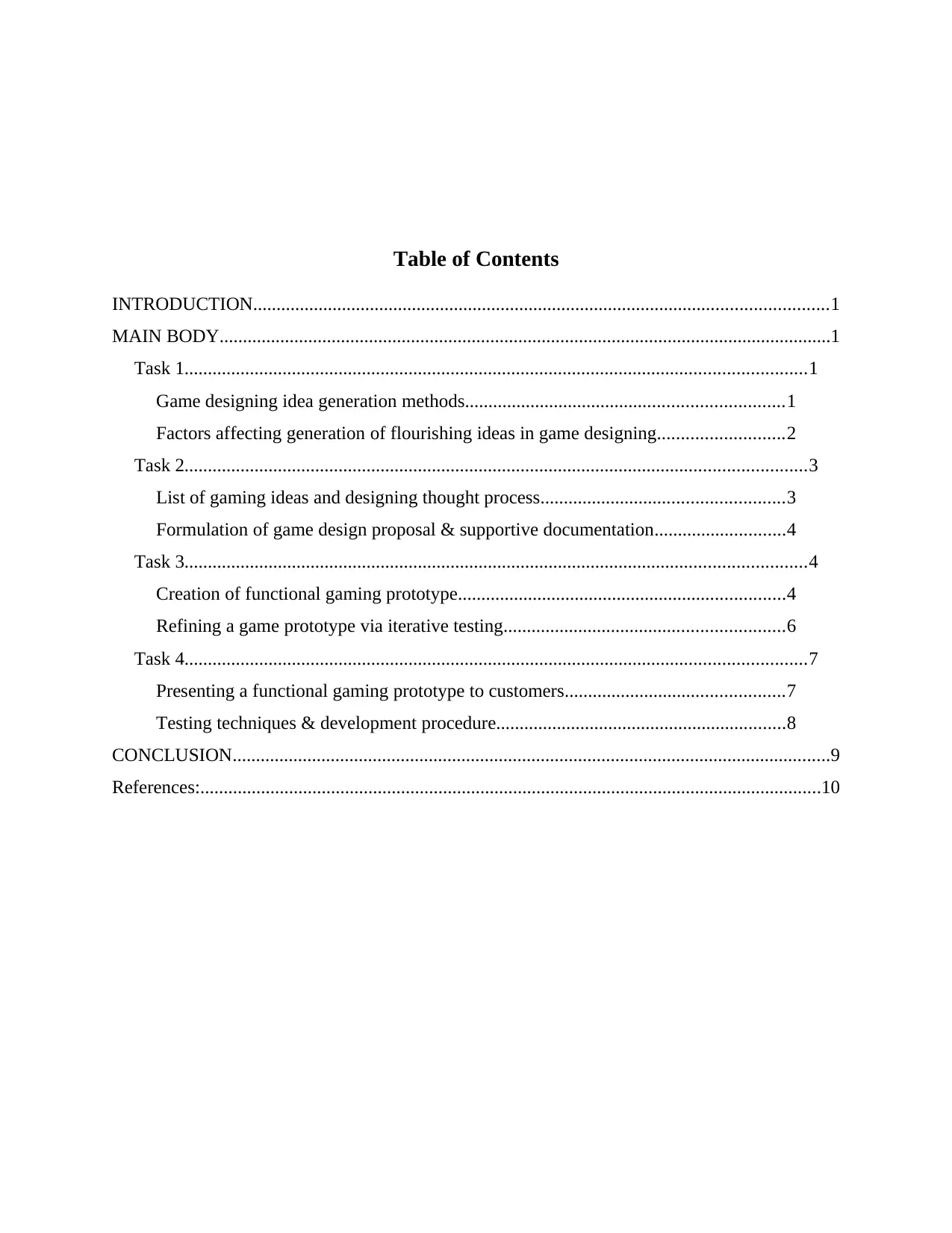
Table of Contents
INTRODUCTION...........................................................................................................................1
MAIN BODY...................................................................................................................................1
Task 1.....................................................................................................................................1
Game designing idea generation methods....................................................................1
Factors affecting generation of flourishing ideas in game designing...........................2
Task 2.....................................................................................................................................3
List of gaming ideas and designing thought process....................................................3
Formulation of game design proposal & supportive documentation............................4
Task 3.....................................................................................................................................4
Creation of functional gaming prototype......................................................................4
Refining a game prototype via iterative testing............................................................6
Task 4.....................................................................................................................................7
Presenting a functional gaming prototype to customers...............................................7
Testing techniques & development procedure..............................................................8
CONCLUSION................................................................................................................................9
References:.....................................................................................................................................10
INTRODUCTION...........................................................................................................................1
MAIN BODY...................................................................................................................................1
Task 1.....................................................................................................................................1
Game designing idea generation methods....................................................................1
Factors affecting generation of flourishing ideas in game designing...........................2
Task 2.....................................................................................................................................3
List of gaming ideas and designing thought process....................................................3
Formulation of game design proposal & supportive documentation............................4
Task 3.....................................................................................................................................4
Creation of functional gaming prototype......................................................................4
Refining a game prototype via iterative testing............................................................6
Task 4.....................................................................................................................................7
Presenting a functional gaming prototype to customers...............................................7
Testing techniques & development procedure..............................................................8
CONCLUSION................................................................................................................................9
References:.....................................................................................................................................10
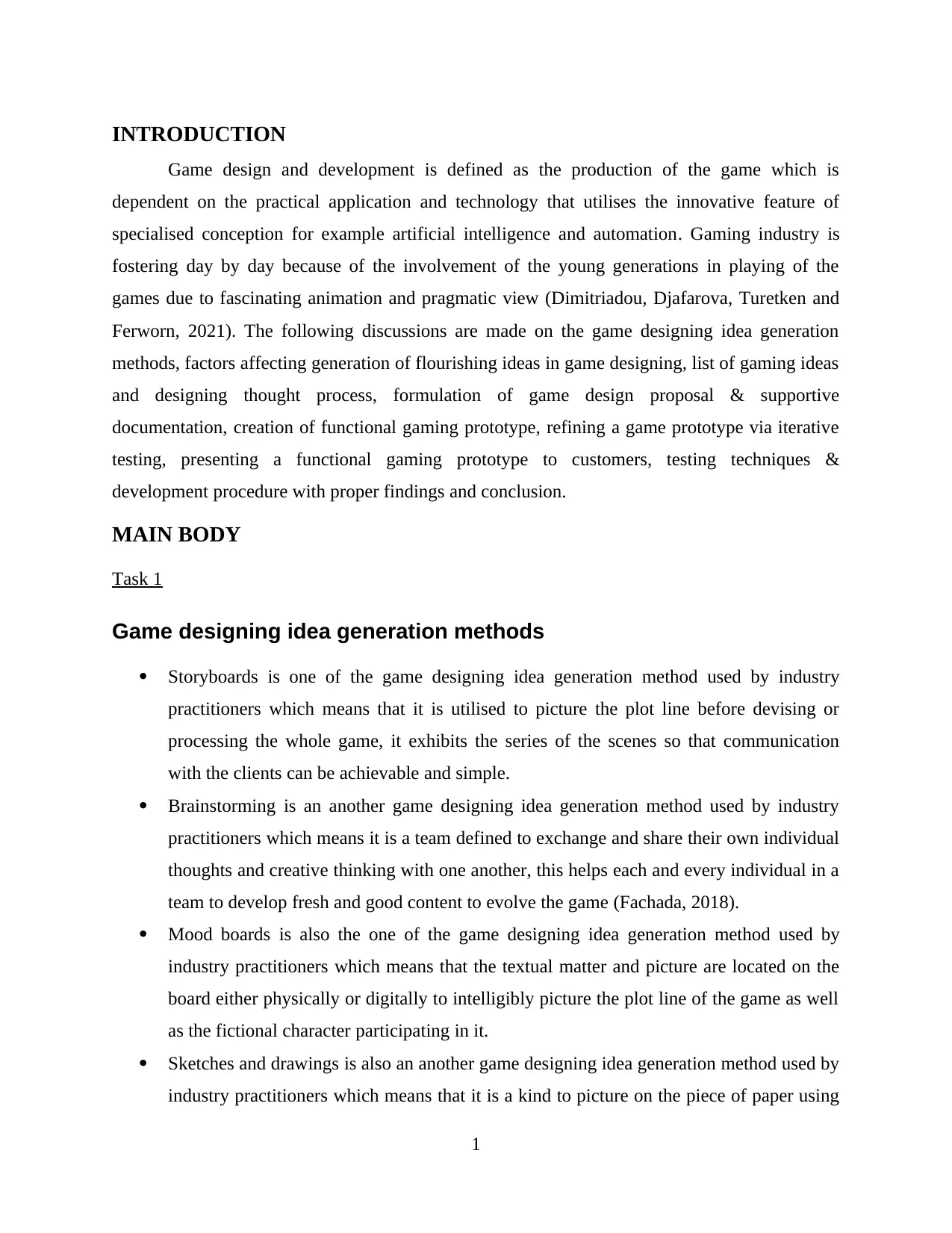
INTRODUCTION
Game design and development is defined as the production of the game which is
dependent on the practical application and technology that utilises the innovative feature of
specialised conception for example artificial intelligence and automation. Gaming industry is
fostering day by day because of the involvement of the young generations in playing of the
games due to fascinating animation and pragmatic view (Dimitriadou, Djafarova, Turetken and
Ferworn, 2021). The following discussions are made on the game designing idea generation
methods, factors affecting generation of flourishing ideas in game designing, list of gaming ideas
and designing thought process, formulation of game design proposal & supportive
documentation, creation of functional gaming prototype, refining a game prototype via iterative
testing, presenting a functional gaming prototype to customers, testing techniques &
development procedure with proper findings and conclusion.
MAIN BODY
Task 1
Game designing idea generation methods
Storyboards is one of the game designing idea generation method used by industry
practitioners which means that it is utilised to picture the plot line before devising or
processing the whole game, it exhibits the series of the scenes so that communication
with the clients can be achievable and simple.
Brainstorming is an another game designing idea generation method used by industry
practitioners which means it is a team defined to exchange and share their own individual
thoughts and creative thinking with one another, this helps each and every individual in a
team to develop fresh and good content to evolve the game (Fachada, 2018).
Mood boards is also the one of the game designing idea generation method used by
industry practitioners which means that the textual matter and picture are located on the
board either physically or digitally to intelligibly picture the plot line of the game as well
as the fictional character participating in it.
Sketches and drawings is also an another game designing idea generation method used by
industry practitioners which means that it is a kind to picture on the piece of paper using
1
Game design and development is defined as the production of the game which is
dependent on the practical application and technology that utilises the innovative feature of
specialised conception for example artificial intelligence and automation. Gaming industry is
fostering day by day because of the involvement of the young generations in playing of the
games due to fascinating animation and pragmatic view (Dimitriadou, Djafarova, Turetken and
Ferworn, 2021). The following discussions are made on the game designing idea generation
methods, factors affecting generation of flourishing ideas in game designing, list of gaming ideas
and designing thought process, formulation of game design proposal & supportive
documentation, creation of functional gaming prototype, refining a game prototype via iterative
testing, presenting a functional gaming prototype to customers, testing techniques &
development procedure with proper findings and conclusion.
MAIN BODY
Task 1
Game designing idea generation methods
Storyboards is one of the game designing idea generation method used by industry
practitioners which means that it is utilised to picture the plot line before devising or
processing the whole game, it exhibits the series of the scenes so that communication
with the clients can be achievable and simple.
Brainstorming is an another game designing idea generation method used by industry
practitioners which means it is a team defined to exchange and share their own individual
thoughts and creative thinking with one another, this helps each and every individual in a
team to develop fresh and good content to evolve the game (Fachada, 2018).
Mood boards is also the one of the game designing idea generation method used by
industry practitioners which means that the textual matter and picture are located on the
board either physically or digitally to intelligibly picture the plot line of the game as well
as the fictional character participating in it.
Sketches and drawings is also an another game designing idea generation method used by
industry practitioners which means that it is a kind to picture on the piece of paper using
1
⊘ This is a preview!⊘
Do you want full access?
Subscribe today to unlock all pages.

Trusted by 1+ million students worldwide
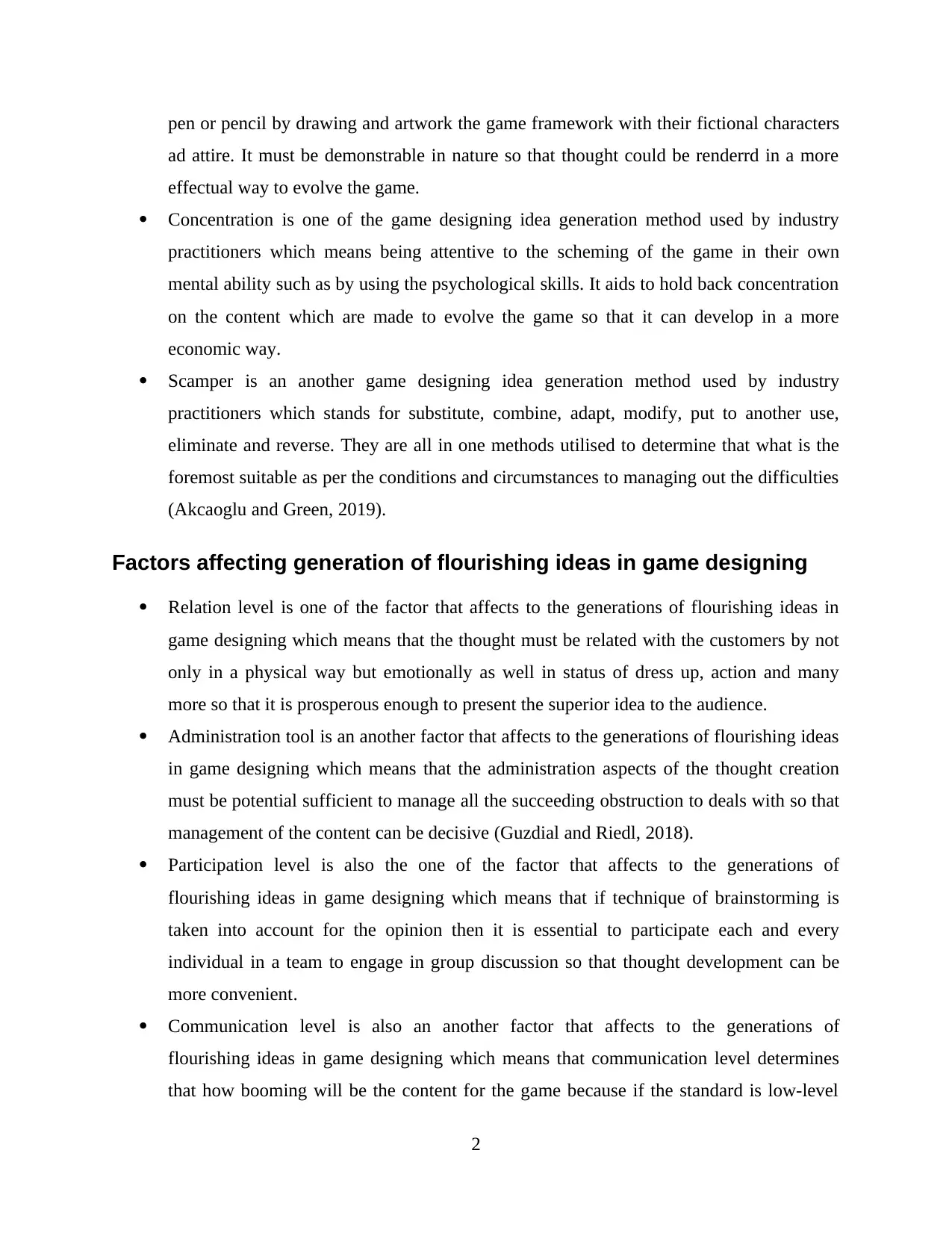
pen or pencil by drawing and artwork the game framework with their fictional characters
ad attire. It must be demonstrable in nature so that thought could be renderrd in a more
effectual way to evolve the game.
Concentration is one of the game designing idea generation method used by industry
practitioners which means being attentive to the scheming of the game in their own
mental ability such as by using the psychological skills. It aids to hold back concentration
on the content which are made to evolve the game so that it can develop in a more
economic way.
Scamper is an another game designing idea generation method used by industry
practitioners which stands for substitute, combine, adapt, modify, put to another use,
eliminate and reverse. They are all in one methods utilised to determine that what is the
foremost suitable as per the conditions and circumstances to managing out the difficulties
(Akcaoglu and Green, 2019).
Factors affecting generation of flourishing ideas in game designing
Relation level is one of the factor that affects to the generations of flourishing ideas in
game designing which means that the thought must be related with the customers by not
only in a physical way but emotionally as well in status of dress up, action and many
more so that it is prosperous enough to present the superior idea to the audience.
Administration tool is an another factor that affects to the generations of flourishing ideas
in game designing which means that the administration aspects of the thought creation
must be potential sufficient to manage all the succeeding obstruction to deals with so that
management of the content can be decisive (Guzdial and Riedl, 2018).
Participation level is also the one of the factor that affects to the generations of
flourishing ideas in game designing which means that if technique of brainstorming is
taken into account for the opinion then it is essential to participate each and every
individual in a team to engage in group discussion so that thought development can be
more convenient.
Communication level is also an another factor that affects to the generations of
flourishing ideas in game designing which means that communication level determines
that how booming will be the content for the game because if the standard is low-level
2
ad attire. It must be demonstrable in nature so that thought could be renderrd in a more
effectual way to evolve the game.
Concentration is one of the game designing idea generation method used by industry
practitioners which means being attentive to the scheming of the game in their own
mental ability such as by using the psychological skills. It aids to hold back concentration
on the content which are made to evolve the game so that it can develop in a more
economic way.
Scamper is an another game designing idea generation method used by industry
practitioners which stands for substitute, combine, adapt, modify, put to another use,
eliminate and reverse. They are all in one methods utilised to determine that what is the
foremost suitable as per the conditions and circumstances to managing out the difficulties
(Akcaoglu and Green, 2019).
Factors affecting generation of flourishing ideas in game designing
Relation level is one of the factor that affects to the generations of flourishing ideas in
game designing which means that the thought must be related with the customers by not
only in a physical way but emotionally as well in status of dress up, action and many
more so that it is prosperous enough to present the superior idea to the audience.
Administration tool is an another factor that affects to the generations of flourishing ideas
in game designing which means that the administration aspects of the thought creation
must be potential sufficient to manage all the succeeding obstruction to deals with so that
management of the content can be decisive (Guzdial and Riedl, 2018).
Participation level is also the one of the factor that affects to the generations of
flourishing ideas in game designing which means that if technique of brainstorming is
taken into account for the opinion then it is essential to participate each and every
individual in a team to engage in group discussion so that thought development can be
more convenient.
Communication level is also an another factor that affects to the generations of
flourishing ideas in game designing which means that communication level determines
that how booming will be the content for the game because if the standard is low-level
2
Paraphrase This Document
Need a fresh take? Get an instant paraphrase of this document with our AI Paraphraser
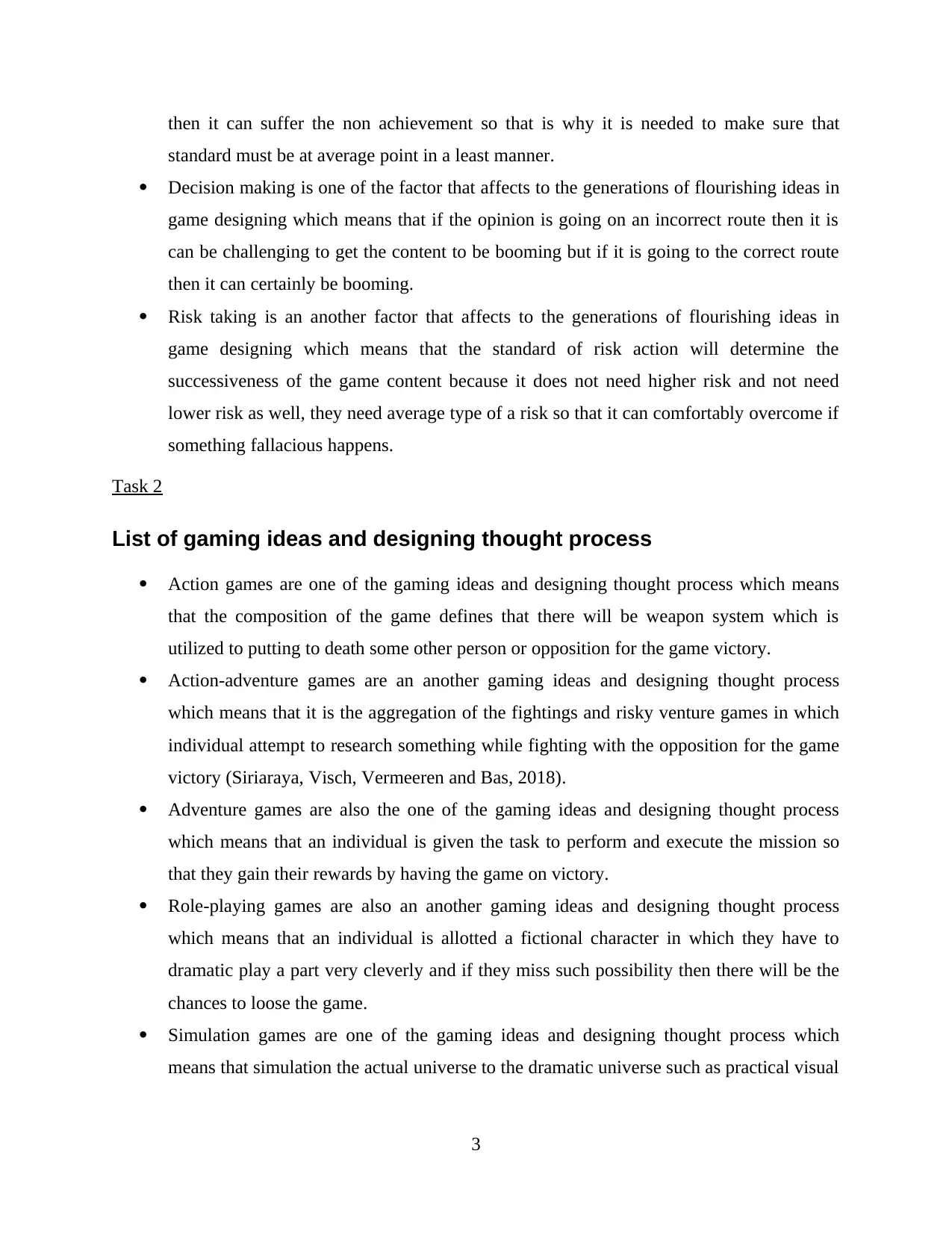
then it can suffer the non achievement so that is why it is needed to make sure that
standard must be at average point in a least manner.
Decision making is one of the factor that affects to the generations of flourishing ideas in
game designing which means that if the opinion is going on an incorrect route then it is
can be challenging to get the content to be booming but if it is going to the correct route
then it can certainly be booming.
Risk taking is an another factor that affects to the generations of flourishing ideas in
game designing which means that the standard of risk action will determine the
successiveness of the game content because it does not need higher risk and not need
lower risk as well, they need average type of a risk so that it can comfortably overcome if
something fallacious happens.
Task 2
List of gaming ideas and designing thought process
Action games are one of the gaming ideas and designing thought process which means
that the composition of the game defines that there will be weapon system which is
utilized to putting to death some other person or opposition for the game victory.
Action-adventure games are an another gaming ideas and designing thought process
which means that it is the aggregation of the fightings and risky venture games in which
individual attempt to research something while fighting with the opposition for the game
victory (Siriaraya, Visch, Vermeeren and Bas, 2018).
Adventure games are also the one of the gaming ideas and designing thought process
which means that an individual is given the task to perform and execute the mission so
that they gain their rewards by having the game on victory.
Role-playing games are also an another gaming ideas and designing thought process
which means that an individual is allotted a fictional character in which they have to
dramatic play a part very cleverly and if they miss such possibility then there will be the
chances to loose the game.
Simulation games are one of the gaming ideas and designing thought process which
means that simulation the actual universe to the dramatic universe such as practical visual
3
standard must be at average point in a least manner.
Decision making is one of the factor that affects to the generations of flourishing ideas in
game designing which means that if the opinion is going on an incorrect route then it is
can be challenging to get the content to be booming but if it is going to the correct route
then it can certainly be booming.
Risk taking is an another factor that affects to the generations of flourishing ideas in
game designing which means that the standard of risk action will determine the
successiveness of the game content because it does not need higher risk and not need
lower risk as well, they need average type of a risk so that it can comfortably overcome if
something fallacious happens.
Task 2
List of gaming ideas and designing thought process
Action games are one of the gaming ideas and designing thought process which means
that the composition of the game defines that there will be weapon system which is
utilized to putting to death some other person or opposition for the game victory.
Action-adventure games are an another gaming ideas and designing thought process
which means that it is the aggregation of the fightings and risky venture games in which
individual attempt to research something while fighting with the opposition for the game
victory (Siriaraya, Visch, Vermeeren and Bas, 2018).
Adventure games are also the one of the gaming ideas and designing thought process
which means that an individual is given the task to perform and execute the mission so
that they gain their rewards by having the game on victory.
Role-playing games are also an another gaming ideas and designing thought process
which means that an individual is allotted a fictional character in which they have to
dramatic play a part very cleverly and if they miss such possibility then there will be the
chances to loose the game.
Simulation games are one of the gaming ideas and designing thought process which
means that simulation the actual universe to the dramatic universe such as practical visual
3
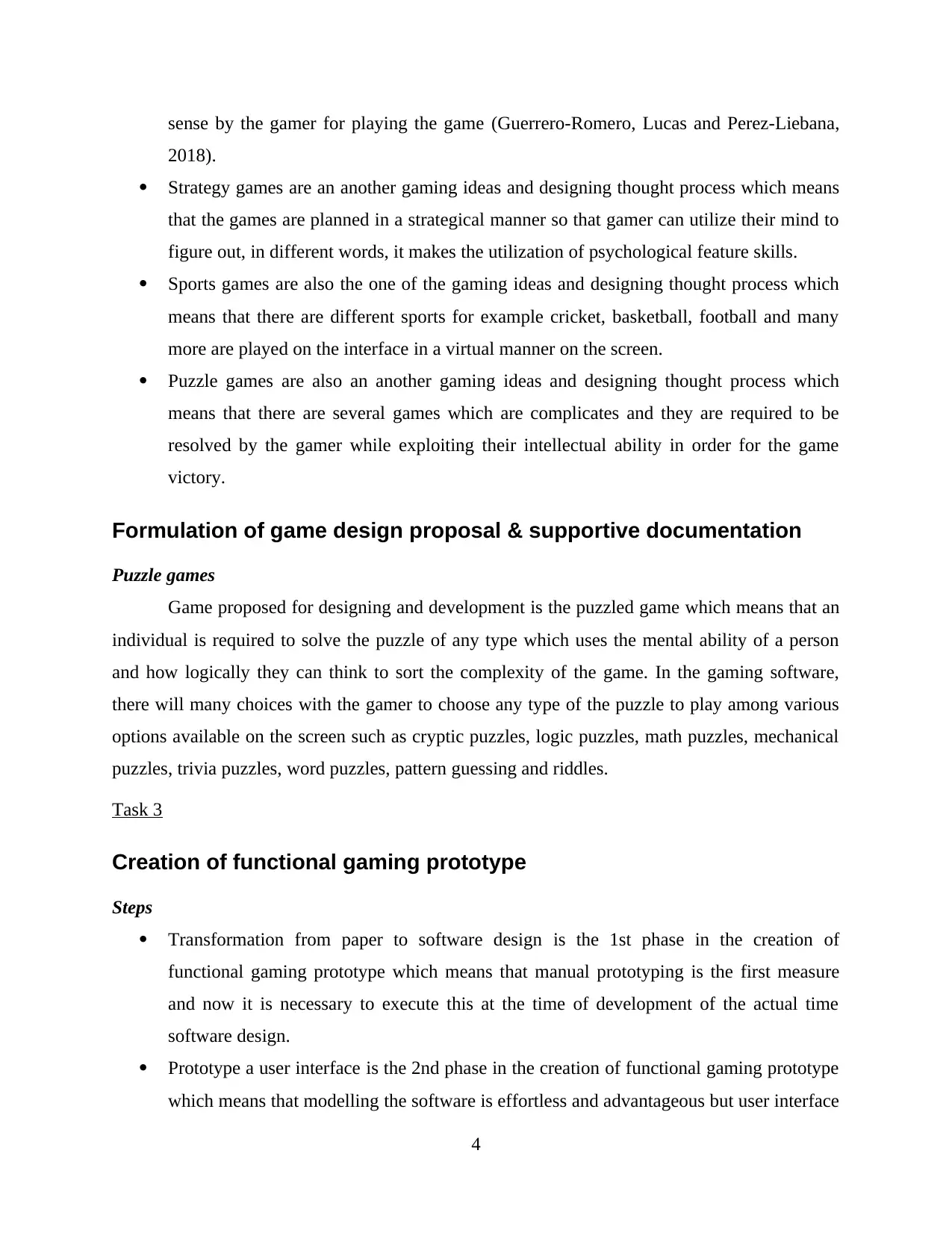
sense by the gamer for playing the game (Guerrero-Romero, Lucas and Perez-Liebana,
2018).
Strategy games are an another gaming ideas and designing thought process which means
that the games are planned in a strategical manner so that gamer can utilize their mind to
figure out, in different words, it makes the utilization of psychological feature skills.
Sports games are also the one of the gaming ideas and designing thought process which
means that there are different sports for example cricket, basketball, football and many
more are played on the interface in a virtual manner on the screen.
Puzzle games are also an another gaming ideas and designing thought process which
means that there are several games which are complicates and they are required to be
resolved by the gamer while exploiting their intellectual ability in order for the game
victory.
Formulation of game design proposal & supportive documentation
Puzzle games
Game proposed for designing and development is the puzzled game which means that an
individual is required to solve the puzzle of any type which uses the mental ability of a person
and how logically they can think to sort the complexity of the game. In the gaming software,
there will many choices with the gamer to choose any type of the puzzle to play among various
options available on the screen such as cryptic puzzles, logic puzzles, math puzzles, mechanical
puzzles, trivia puzzles, word puzzles, pattern guessing and riddles.
Task 3
Creation of functional gaming prototype
Steps
Transformation from paper to software design is the 1st phase in the creation of
functional gaming prototype which means that manual prototyping is the first measure
and now it is necessary to execute this at the time of development of the actual time
software design.
Prototype a user interface is the 2nd phase in the creation of functional gaming prototype
which means that modelling the software is effortless and advantageous but user interface
4
2018).
Strategy games are an another gaming ideas and designing thought process which means
that the games are planned in a strategical manner so that gamer can utilize their mind to
figure out, in different words, it makes the utilization of psychological feature skills.
Sports games are also the one of the gaming ideas and designing thought process which
means that there are different sports for example cricket, basketball, football and many
more are played on the interface in a virtual manner on the screen.
Puzzle games are also an another gaming ideas and designing thought process which
means that there are several games which are complicates and they are required to be
resolved by the gamer while exploiting their intellectual ability in order for the game
victory.
Formulation of game design proposal & supportive documentation
Puzzle games
Game proposed for designing and development is the puzzled game which means that an
individual is required to solve the puzzle of any type which uses the mental ability of a person
and how logically they can think to sort the complexity of the game. In the gaming software,
there will many choices with the gamer to choose any type of the puzzle to play among various
options available on the screen such as cryptic puzzles, logic puzzles, math puzzles, mechanical
puzzles, trivia puzzles, word puzzles, pattern guessing and riddles.
Task 3
Creation of functional gaming prototype
Steps
Transformation from paper to software design is the 1st phase in the creation of
functional gaming prototype which means that manual prototyping is the first measure
and now it is necessary to execute this at the time of development of the actual time
software design.
Prototype a user interface is the 2nd phase in the creation of functional gaming prototype
which means that modelling the software is effortless and advantageous but user interface
4
⊘ This is a preview!⊘
Do you want full access?
Subscribe today to unlock all pages.

Trusted by 1+ million students worldwide
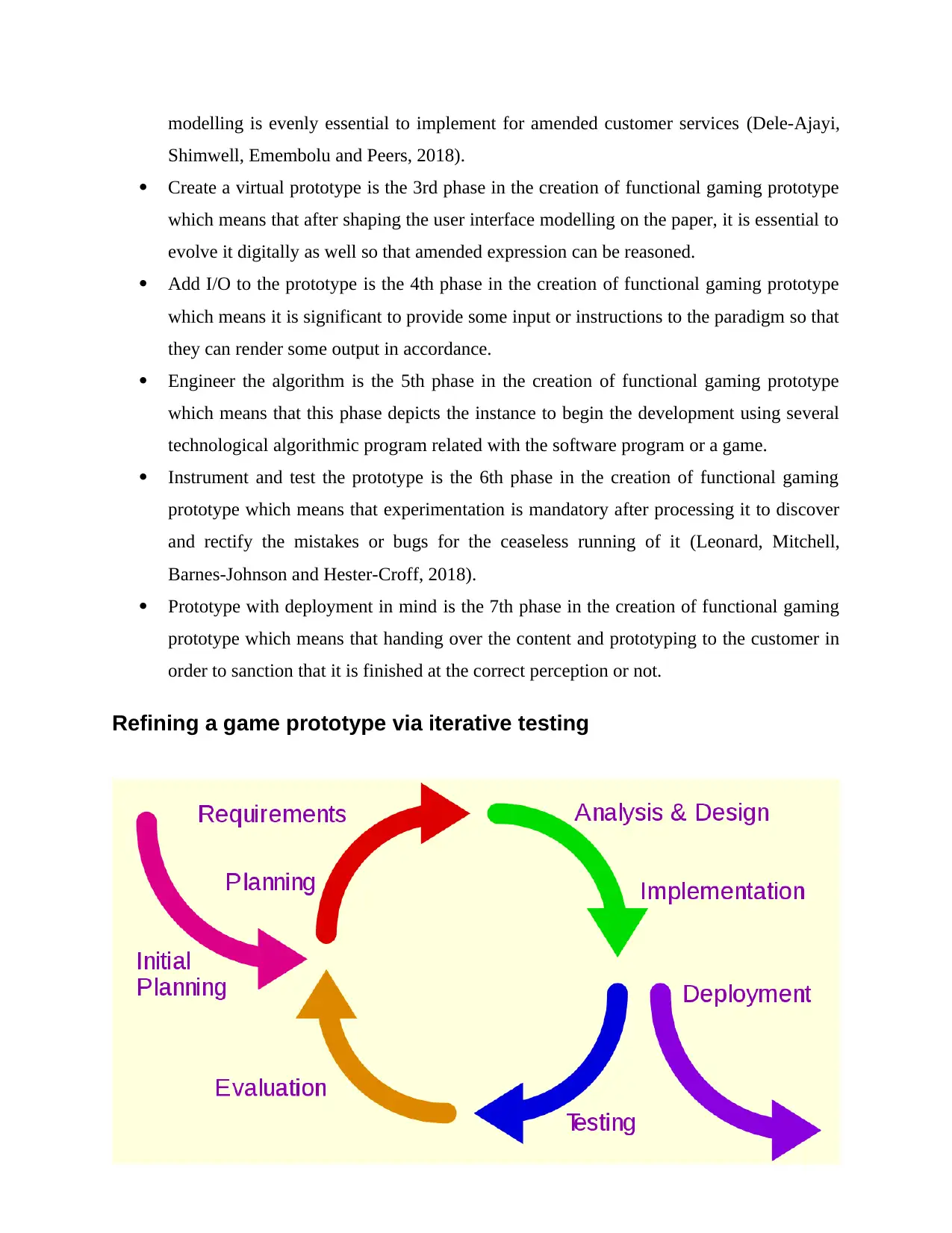
modelling is evenly essential to implement for amended customer services (Dele-Ajayi,
Shimwell, Emembolu and Peers, 2018).
Create a virtual prototype is the 3rd phase in the creation of functional gaming prototype
which means that after shaping the user interface modelling on the paper, it is essential to
evolve it digitally as well so that amended expression can be reasoned.
Add I/O to the prototype is the 4th phase in the creation of functional gaming prototype
which means it is significant to provide some input or instructions to the paradigm so that
they can render some output in accordance.
Engineer the algorithm is the 5th phase in the creation of functional gaming prototype
which means that this phase depicts the instance to begin the development using several
technological algorithmic program related with the software program or a game.
Instrument and test the prototype is the 6th phase in the creation of functional gaming
prototype which means that experimentation is mandatory after processing it to discover
and rectify the mistakes or bugs for the ceaseless running of it (Leonard, Mitchell,
Barnes-Johnson and Hester-Croff, 2018).
Prototype with deployment in mind is the 7th phase in the creation of functional gaming
prototype which means that handing over the content and prototyping to the customer in
order to sanction that it is finished at the correct perception or not.
Refining a game prototype via iterative testing
5
Shimwell, Emembolu and Peers, 2018).
Create a virtual prototype is the 3rd phase in the creation of functional gaming prototype
which means that after shaping the user interface modelling on the paper, it is essential to
evolve it digitally as well so that amended expression can be reasoned.
Add I/O to the prototype is the 4th phase in the creation of functional gaming prototype
which means it is significant to provide some input or instructions to the paradigm so that
they can render some output in accordance.
Engineer the algorithm is the 5th phase in the creation of functional gaming prototype
which means that this phase depicts the instance to begin the development using several
technological algorithmic program related with the software program or a game.
Instrument and test the prototype is the 6th phase in the creation of functional gaming
prototype which means that experimentation is mandatory after processing it to discover
and rectify the mistakes or bugs for the ceaseless running of it (Leonard, Mitchell,
Barnes-Johnson and Hester-Croff, 2018).
Prototype with deployment in mind is the 7th phase in the creation of functional gaming
prototype which means that handing over the content and prototyping to the customer in
order to sanction that it is finished at the correct perception or not.
Refining a game prototype via iterative testing
5
Paraphrase This Document
Need a fresh take? Get an instant paraphrase of this document with our AI Paraphraser
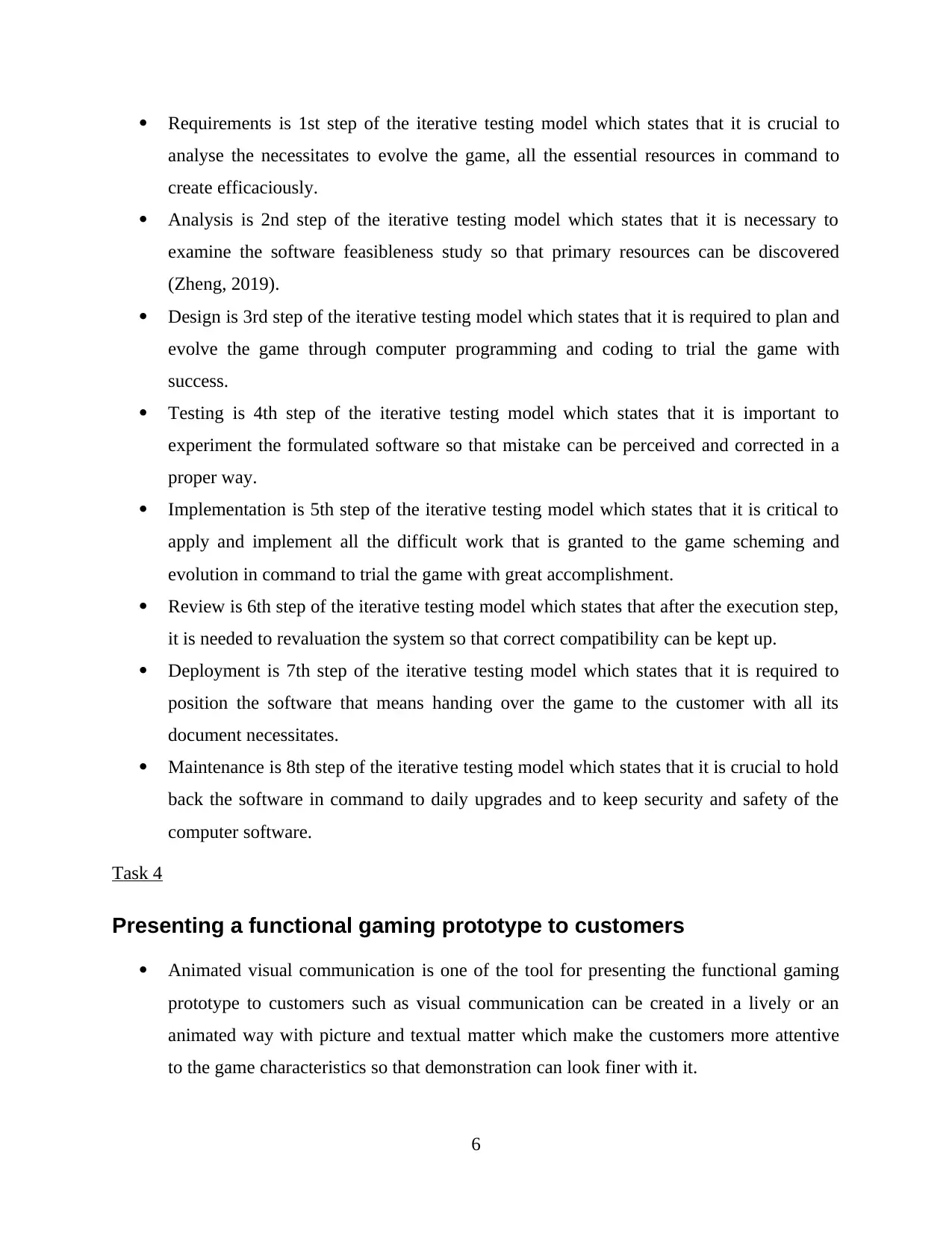
Requirements is 1st step of the iterative testing model which states that it is crucial to
analyse the necessitates to evolve the game, all the essential resources in command to
create efficaciously.
Analysis is 2nd step of the iterative testing model which states that it is necessary to
examine the software feasibleness study so that primary resources can be discovered
(Zheng, 2019).
Design is 3rd step of the iterative testing model which states that it is required to plan and
evolve the game through computer programming and coding to trial the game with
success.
Testing is 4th step of the iterative testing model which states that it is important to
experiment the formulated software so that mistake can be perceived and corrected in a
proper way.
Implementation is 5th step of the iterative testing model which states that it is critical to
apply and implement all the difficult work that is granted to the game scheming and
evolution in command to trial the game with great accomplishment.
Review is 6th step of the iterative testing model which states that after the execution step,
it is needed to revaluation the system so that correct compatibility can be kept up.
Deployment is 7th step of the iterative testing model which states that it is required to
position the software that means handing over the game to the customer with all its
document necessitates.
Maintenance is 8th step of the iterative testing model which states that it is crucial to hold
back the software in command to daily upgrades and to keep security and safety of the
computer software.
Task 4
Presenting a functional gaming prototype to customers
Animated visual communication is one of the tool for presenting the functional gaming
prototype to customers such as visual communication can be created in a lively or an
animated way with picture and textual matter which make the customers more attentive
to the game characteristics so that demonstration can look finer with it.
6
analyse the necessitates to evolve the game, all the essential resources in command to
create efficaciously.
Analysis is 2nd step of the iterative testing model which states that it is necessary to
examine the software feasibleness study so that primary resources can be discovered
(Zheng, 2019).
Design is 3rd step of the iterative testing model which states that it is required to plan and
evolve the game through computer programming and coding to trial the game with
success.
Testing is 4th step of the iterative testing model which states that it is important to
experiment the formulated software so that mistake can be perceived and corrected in a
proper way.
Implementation is 5th step of the iterative testing model which states that it is critical to
apply and implement all the difficult work that is granted to the game scheming and
evolution in command to trial the game with great accomplishment.
Review is 6th step of the iterative testing model which states that after the execution step,
it is needed to revaluation the system so that correct compatibility can be kept up.
Deployment is 7th step of the iterative testing model which states that it is required to
position the software that means handing over the game to the customer with all its
document necessitates.
Maintenance is 8th step of the iterative testing model which states that it is crucial to hold
back the software in command to daily upgrades and to keep security and safety of the
computer software.
Task 4
Presenting a functional gaming prototype to customers
Animated visual communication is one of the tool for presenting the functional gaming
prototype to customers such as visual communication can be created in a lively or an
animated way with picture and textual matter which make the customers more attentive
to the game characteristics so that demonstration can look finer with it.
6
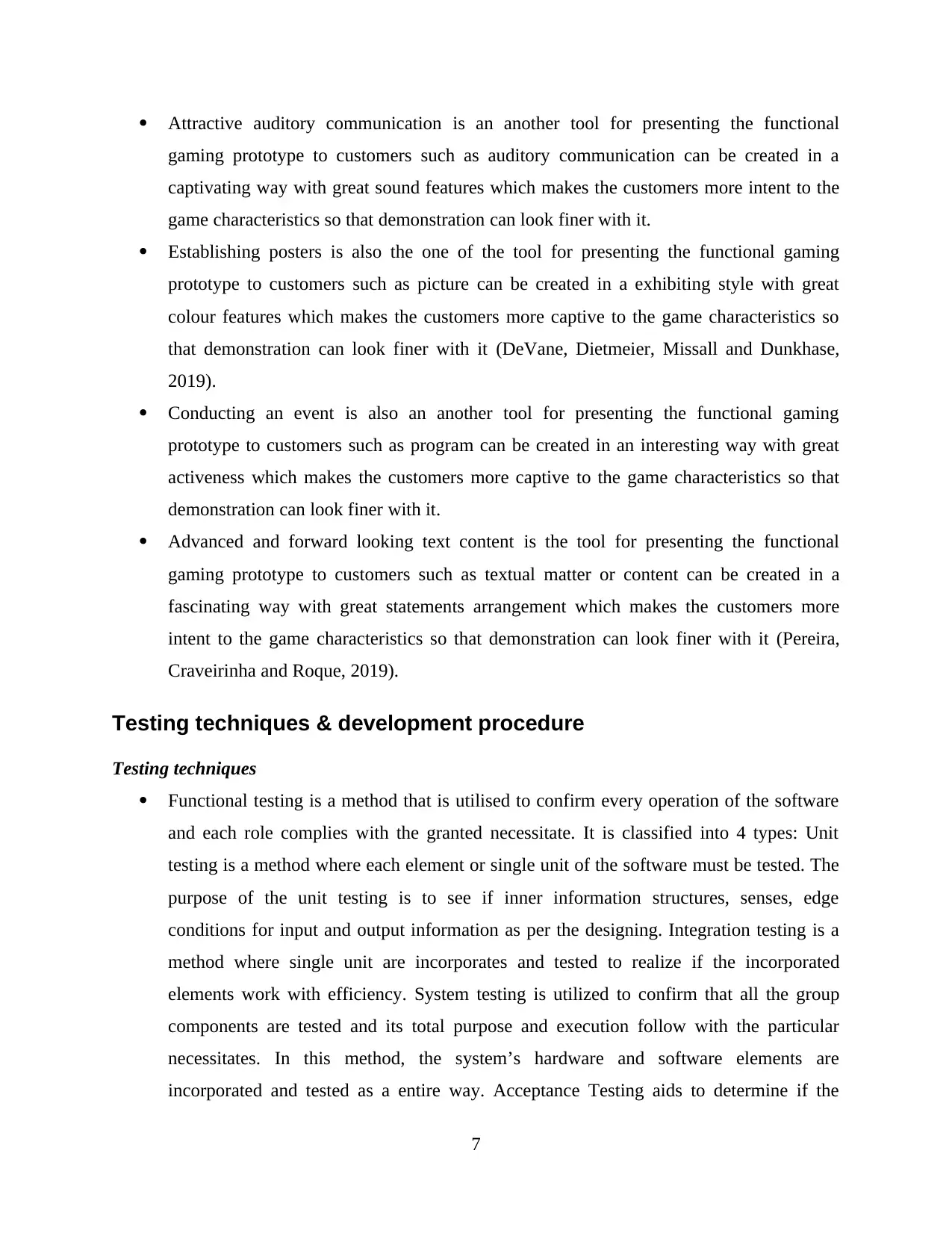
Attractive auditory communication is an another tool for presenting the functional
gaming prototype to customers such as auditory communication can be created in a
captivating way with great sound features which makes the customers more intent to the
game characteristics so that demonstration can look finer with it.
Establishing posters is also the one of the tool for presenting the functional gaming
prototype to customers such as picture can be created in a exhibiting style with great
colour features which makes the customers more captive to the game characteristics so
that demonstration can look finer with it (DeVane, Dietmeier, Missall and Dunkhase,
2019).
Conducting an event is also an another tool for presenting the functional gaming
prototype to customers such as program can be created in an interesting way with great
activeness which makes the customers more captive to the game characteristics so that
demonstration can look finer with it.
Advanced and forward looking text content is the tool for presenting the functional
gaming prototype to customers such as textual matter or content can be created in a
fascinating way with great statements arrangement which makes the customers more
intent to the game characteristics so that demonstration can look finer with it (Pereira,
Craveirinha and Roque, 2019).
Testing techniques & development procedure
Testing techniques
Functional testing is a method that is utilised to confirm every operation of the software
and each role complies with the granted necessitate. It is classified into 4 types: Unit
testing is a method where each element or single unit of the software must be tested. The
purpose of the unit testing is to see if inner information structures, senses, edge
conditions for input and output information as per the designing. Integration testing is a
method where single unit are incorporates and tested to realize if the incorporated
elements work with efficiency. System testing is utilized to confirm that all the group
components are tested and its total purpose and execution follow with the particular
necessitates. In this method, the system’s hardware and software elements are
incorporated and tested as a entire way. Acceptance Testing aids to determine if the
7
gaming prototype to customers such as auditory communication can be created in a
captivating way with great sound features which makes the customers more intent to the
game characteristics so that demonstration can look finer with it.
Establishing posters is also the one of the tool for presenting the functional gaming
prototype to customers such as picture can be created in a exhibiting style with great
colour features which makes the customers more captive to the game characteristics so
that demonstration can look finer with it (DeVane, Dietmeier, Missall and Dunkhase,
2019).
Conducting an event is also an another tool for presenting the functional gaming
prototype to customers such as program can be created in an interesting way with great
activeness which makes the customers more captive to the game characteristics so that
demonstration can look finer with it.
Advanced and forward looking text content is the tool for presenting the functional
gaming prototype to customers such as textual matter or content can be created in a
fascinating way with great statements arrangement which makes the customers more
intent to the game characteristics so that demonstration can look finer with it (Pereira,
Craveirinha and Roque, 2019).
Testing techniques & development procedure
Testing techniques
Functional testing is a method that is utilised to confirm every operation of the software
and each role complies with the granted necessitate. It is classified into 4 types: Unit
testing is a method where each element or single unit of the software must be tested. The
purpose of the unit testing is to see if inner information structures, senses, edge
conditions for input and output information as per the designing. Integration testing is a
method where single unit are incorporates and tested to realize if the incorporated
elements work with efficiency. System testing is utilized to confirm that all the group
components are tested and its total purpose and execution follow with the particular
necessitates. In this method, the system’s hardware and software elements are
incorporated and tested as a entire way. Acceptance Testing aids to determine if the
7
⊘ This is a preview!⊘
Do you want full access?
Subscribe today to unlock all pages.

Trusted by 1+ million students worldwide
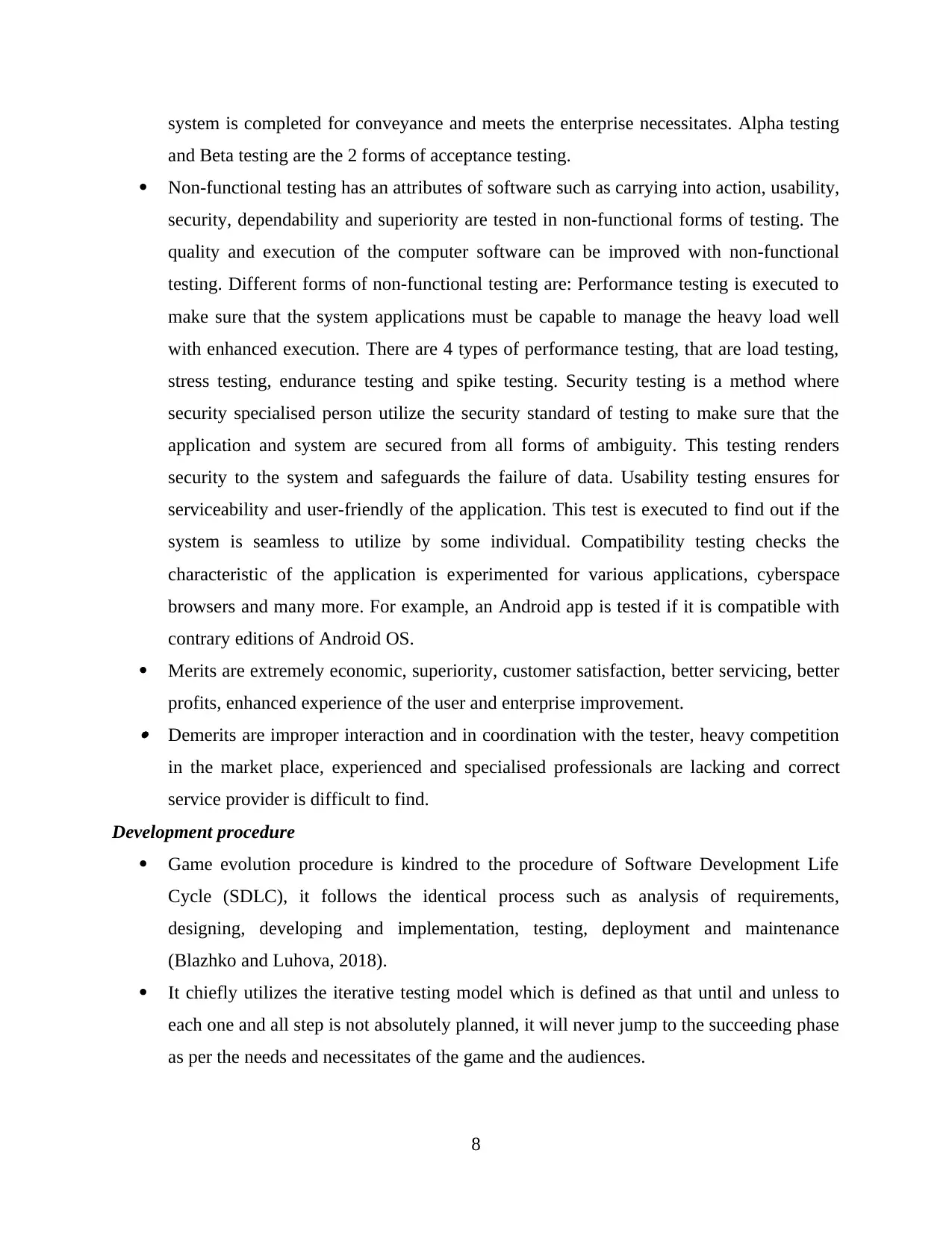
system is completed for conveyance and meets the enterprise necessitates. Alpha testing
and Beta testing are the 2 forms of acceptance testing.
Non-functional testing has an attributes of software such as carrying into action, usability,
security, dependability and superiority are tested in non-functional forms of testing. The
quality and execution of the computer software can be improved with non-functional
testing. Different forms of non-functional testing are: Performance testing is executed to
make sure that the system applications must be capable to manage the heavy load well
with enhanced execution. There are 4 types of performance testing, that are load testing,
stress testing, endurance testing and spike testing. Security testing is a method where
security specialised person utilize the security standard of testing to make sure that the
application and system are secured from all forms of ambiguity. This testing renders
security to the system and safeguards the failure of data. Usability testing ensures for
serviceability and user-friendly of the application. This test is executed to find out if the
system is seamless to utilize by some individual. Compatibility testing checks the
characteristic of the application is experimented for various applications, cyberspace
browsers and many more. For example, an Android app is tested if it is compatible with
contrary editions of Android OS.
Merits are extremely economic, superiority, customer satisfaction, better servicing, better
profits, enhanced experience of the user and enterprise improvement. Demerits are improper interaction and in coordination with the tester, heavy competition
in the market place, experienced and specialised professionals are lacking and correct
service provider is difficult to find.
Development procedure
Game evolution procedure is kindred to the procedure of Software Development Life
Cycle (SDLC), it follows the identical process such as analysis of requirements,
designing, developing and implementation, testing, deployment and maintenance
(Blazhko and Luhova, 2018).
It chiefly utilizes the iterative testing model which is defined as that until and unless to
each one and all step is not absolutely planned, it will never jump to the succeeding phase
as per the needs and necessitates of the game and the audiences.
8
and Beta testing are the 2 forms of acceptance testing.
Non-functional testing has an attributes of software such as carrying into action, usability,
security, dependability and superiority are tested in non-functional forms of testing. The
quality and execution of the computer software can be improved with non-functional
testing. Different forms of non-functional testing are: Performance testing is executed to
make sure that the system applications must be capable to manage the heavy load well
with enhanced execution. There are 4 types of performance testing, that are load testing,
stress testing, endurance testing and spike testing. Security testing is a method where
security specialised person utilize the security standard of testing to make sure that the
application and system are secured from all forms of ambiguity. This testing renders
security to the system and safeguards the failure of data. Usability testing ensures for
serviceability and user-friendly of the application. This test is executed to find out if the
system is seamless to utilize by some individual. Compatibility testing checks the
characteristic of the application is experimented for various applications, cyberspace
browsers and many more. For example, an Android app is tested if it is compatible with
contrary editions of Android OS.
Merits are extremely economic, superiority, customer satisfaction, better servicing, better
profits, enhanced experience of the user and enterprise improvement. Demerits are improper interaction and in coordination with the tester, heavy competition
in the market place, experienced and specialised professionals are lacking and correct
service provider is difficult to find.
Development procedure
Game evolution procedure is kindred to the procedure of Software Development Life
Cycle (SDLC), it follows the identical process such as analysis of requirements,
designing, developing and implementation, testing, deployment and maintenance
(Blazhko and Luhova, 2018).
It chiefly utilizes the iterative testing model which is defined as that until and unless to
each one and all step is not absolutely planned, it will never jump to the succeeding phase
as per the needs and necessitates of the game and the audiences.
8
Paraphrase This Document
Need a fresh take? Get an instant paraphrase of this document with our AI Paraphraser
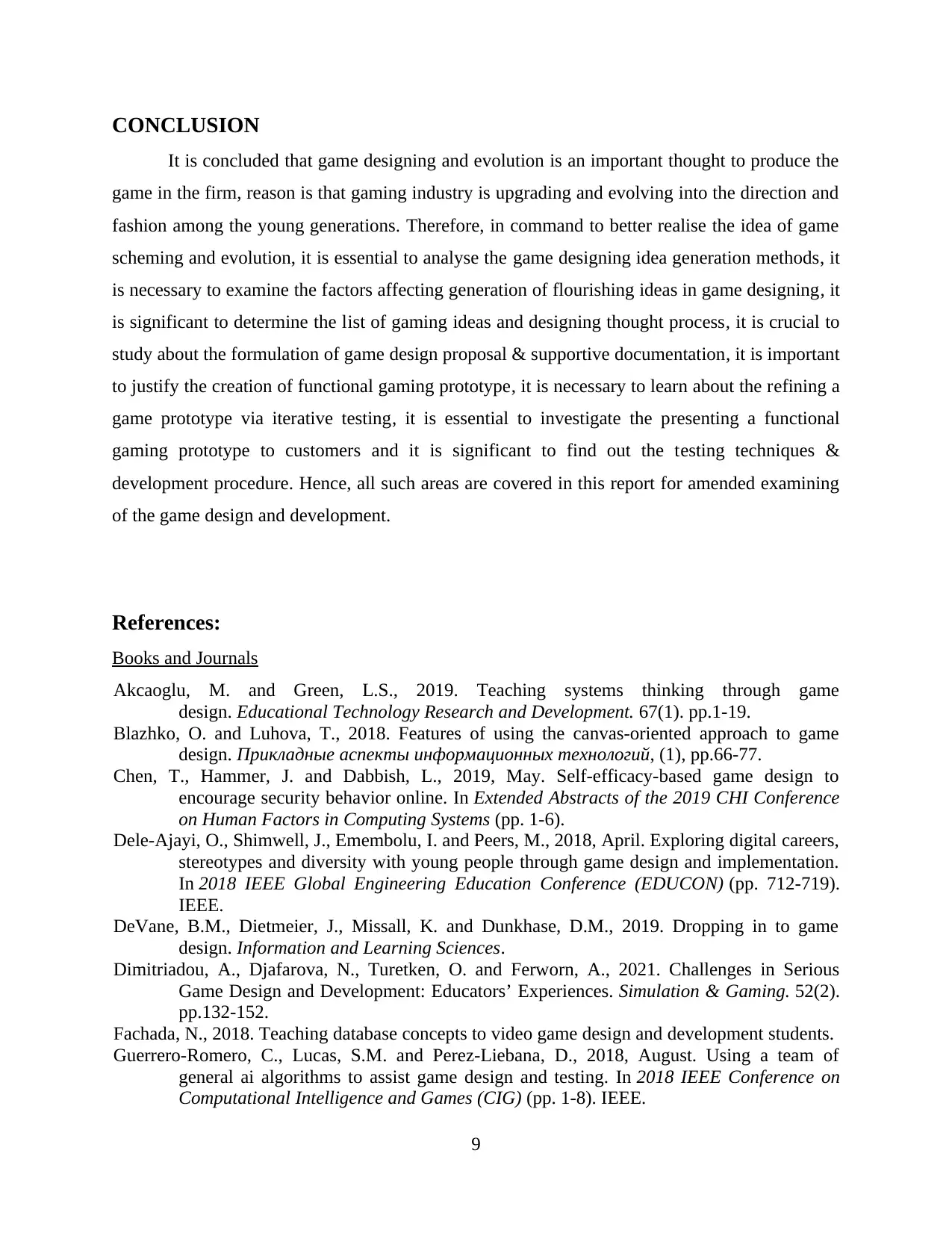
CONCLUSION
It is concluded that game designing and evolution is an important thought to produce the
game in the firm, reason is that gaming industry is upgrading and evolving into the direction and
fashion among the young generations. Therefore, in command to better realise the idea of game
scheming and evolution, it is essential to analyse the game designing idea generation methods, it
is necessary to examine the factors affecting generation of flourishing ideas in game designing, it
is significant to determine the list of gaming ideas and designing thought process, it is crucial to
study about the formulation of game design proposal & supportive documentation, it is important
to justify the creation of functional gaming prototype, it is necessary to learn about the refining a
game prototype via iterative testing, it is essential to investigate the presenting a functional
gaming prototype to customers and it is significant to find out the testing techniques &
development procedure. Hence, all such areas are covered in this report for amended examining
of the game design and development.
References:
Books and Journals
Akcaoglu, M. and Green, L.S., 2019. Teaching systems thinking through game
design. Educational Technology Research and Development. 67(1). pp.1-19.
Blazhko, O. and Luhova, T., 2018. Features of using the canvas-oriented approach to game
design. Прикладные аспекты информационных технологий, (1), pp.66-77.
Chen, T., Hammer, J. and Dabbish, L., 2019, May. Self-efficacy-based game design to
encourage security behavior online. In Extended Abstracts of the 2019 CHI Conference
on Human Factors in Computing Systems (pp. 1-6).
Dele-Ajayi, O., Shimwell, J., Emembolu, I. and Peers, M., 2018, April. Exploring digital careers,
stereotypes and diversity with young people through game design and implementation.
In 2018 IEEE Global Engineering Education Conference (EDUCON) (pp. 712-719).
IEEE.
DeVane, B.M., Dietmeier, J., Missall, K. and Dunkhase, D.M., 2019. Dropping in to game
design. Information and Learning Sciences.
Dimitriadou, A., Djafarova, N., Turetken, O. and Ferworn, A., 2021. Challenges in Serious
Game Design and Development: Educators’ Experiences. Simulation & Gaming. 52(2).
pp.132-152.
Fachada, N., 2018. Teaching database concepts to video game design and development students.
Guerrero-Romero, C., Lucas, S.M. and Perez-Liebana, D., 2018, August. Using a team of
general ai algorithms to assist game design and testing. In 2018 IEEE Conference on
Computational Intelligence and Games (CIG) (pp. 1-8). IEEE.
9
It is concluded that game designing and evolution is an important thought to produce the
game in the firm, reason is that gaming industry is upgrading and evolving into the direction and
fashion among the young generations. Therefore, in command to better realise the idea of game
scheming and evolution, it is essential to analyse the game designing idea generation methods, it
is necessary to examine the factors affecting generation of flourishing ideas in game designing, it
is significant to determine the list of gaming ideas and designing thought process, it is crucial to
study about the formulation of game design proposal & supportive documentation, it is important
to justify the creation of functional gaming prototype, it is necessary to learn about the refining a
game prototype via iterative testing, it is essential to investigate the presenting a functional
gaming prototype to customers and it is significant to find out the testing techniques &
development procedure. Hence, all such areas are covered in this report for amended examining
of the game design and development.
References:
Books and Journals
Akcaoglu, M. and Green, L.S., 2019. Teaching systems thinking through game
design. Educational Technology Research and Development. 67(1). pp.1-19.
Blazhko, O. and Luhova, T., 2018. Features of using the canvas-oriented approach to game
design. Прикладные аспекты информационных технологий, (1), pp.66-77.
Chen, T., Hammer, J. and Dabbish, L., 2019, May. Self-efficacy-based game design to
encourage security behavior online. In Extended Abstracts of the 2019 CHI Conference
on Human Factors in Computing Systems (pp. 1-6).
Dele-Ajayi, O., Shimwell, J., Emembolu, I. and Peers, M., 2018, April. Exploring digital careers,
stereotypes and diversity with young people through game design and implementation.
In 2018 IEEE Global Engineering Education Conference (EDUCON) (pp. 712-719).
IEEE.
DeVane, B.M., Dietmeier, J., Missall, K. and Dunkhase, D.M., 2019. Dropping in to game
design. Information and Learning Sciences.
Dimitriadou, A., Djafarova, N., Turetken, O. and Ferworn, A., 2021. Challenges in Serious
Game Design and Development: Educators’ Experiences. Simulation & Gaming. 52(2).
pp.132-152.
Fachada, N., 2018. Teaching database concepts to video game design and development students.
Guerrero-Romero, C., Lucas, S.M. and Perez-Liebana, D., 2018, August. Using a team of
general ai algorithms to assist game design and testing. In 2018 IEEE Conference on
Computational Intelligence and Games (CIG) (pp. 1-8). IEEE.
9

Guzdial, M. and Riedl, M., 2018, September. Automated game design via conceptual expansion.
In Proceedings of the AAAI Conference on Artificial Intelligence and Interactive Digital
Entertainment (Vol. 14, No. 1).
Khaled, R., 2018. Questions over answers: Reflective game design. In Playful disruption of
digital media (pp. 3-27). Springer, Singapore.
Leonard, J., Mitchell, M., Barnes-Johnson, J. and Hester-Croff, C., 2018. Preparing teachers to
engage rural students in computational thinking through robotics, game design, and
culturally responsive teaching. Journal of Teacher Education. 69(4). pp.386-407.
Pereira, L.L., Craveirinha, R. and Roque, L., 2019, October. A Canvas for Participation-
Centered Game Design. In Proceedings of the Annual Symposium on Computer-Human
Interaction in Play (pp. 521-532).
Siriaraya, P., Visch, V., Vermeeren, A. and Bas, M., 2018. A cookbook method for Persuasive
Game Design. International Journal of Serious Games. 5(1). pp.37-71.
Zheng, Y., 2019. 3D Course Teaching Based on Educational Game Development Theory-Case
Study of Game Design Course. International Journal of Emerging Technologies in
Learning. 14(2).
10
In Proceedings of the AAAI Conference on Artificial Intelligence and Interactive Digital
Entertainment (Vol. 14, No. 1).
Khaled, R., 2018. Questions over answers: Reflective game design. In Playful disruption of
digital media (pp. 3-27). Springer, Singapore.
Leonard, J., Mitchell, M., Barnes-Johnson, J. and Hester-Croff, C., 2018. Preparing teachers to
engage rural students in computational thinking through robotics, game design, and
culturally responsive teaching. Journal of Teacher Education. 69(4). pp.386-407.
Pereira, L.L., Craveirinha, R. and Roque, L., 2019, October. A Canvas for Participation-
Centered Game Design. In Proceedings of the Annual Symposium on Computer-Human
Interaction in Play (pp. 521-532).
Siriaraya, P., Visch, V., Vermeeren, A. and Bas, M., 2018. A cookbook method for Persuasive
Game Design. International Journal of Serious Games. 5(1). pp.37-71.
Zheng, Y., 2019. 3D Course Teaching Based on Educational Game Development Theory-Case
Study of Game Design Course. International Journal of Emerging Technologies in
Learning. 14(2).
10
⊘ This is a preview!⊘
Do you want full access?
Subscribe today to unlock all pages.

Trusted by 1+ million students worldwide
1 out of 12
Related Documents
Your All-in-One AI-Powered Toolkit for Academic Success.
+13062052269
info@desklib.com
Available 24*7 on WhatsApp / Email
![[object Object]](/_next/static/media/star-bottom.7253800d.svg)
Unlock your academic potential
Copyright © 2020–2025 A2Z Services. All Rights Reserved. Developed and managed by ZUCOL.





